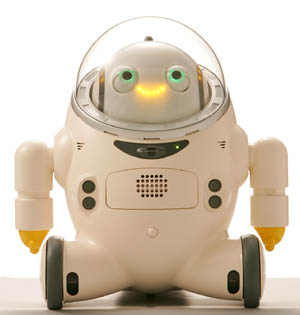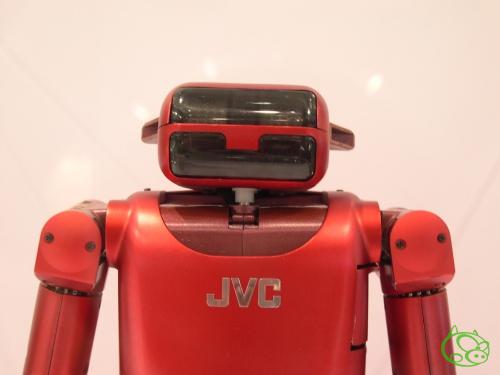Robotory: “Honda Reveals Technologies Next-Generation ASIMO” : Photos Gallery !
Author Archives: Ogen
Honda Worldwide | HDTV | ASIMO
ASIMO (II) Videos !
| Honda Reveals Technologies Next-Generation ASIMO |
TOKYO, Japan, December 15, 2004 – Honda Motor Co., Ltd. today announced the development of new technologies for the next-generation ASIMO humanoid robot, targeting a new level of mobility that will better enable ASIMO to function and interact with people by quickly processing information and acting more nimbly in real-world environments.
Key technologies include:
| 1) | “Posture Control” technology* making it possible to run in a natural human-like way |
| 2) | “Autonomous Continuous Movement” technology enabling flexible route to destination |
| 3) | Enhanced visual and force sensor technologies enabling smoother interaction with people |
1.Posture Control technology:
| The combination of newly developed high-response hardware and the new Posture Control technology enables ASIMO to proactively bend or twist its torso to maintain its balance and prevent the problems of foot slippage and spinning in the air, which accompany movement at higher speeds. ASIMO is now capable of running at a speed of 3km/hour. In addition, walking speed has been increased from the previous 1.6 km/hour to 2.5 km/hour. |
2.Autonomous Continuous Movement technology:
| The next-generation ASIMO can maneuver toward its destination without stopping by comparing any deviation between the input map information and the information obtained about the surrounding area from its floor surface sensor. ASIMO can now autonomously change its path when its floor surface sensor and visual sensors located in its head detect obstacles. |
3.Enhanced visual sensor and force sensor technologies allow for smoother interaction with people:
| By detecting people’s movements through visual sensors in its head and force (kinesthetic) sensors which have been newly added to its wrists, ASIMO can now move in sync with people allowing it to give or receive an object, shake hands in concert with a person’s movement and step forward or backward in response to the direction its hand is pulled or pushed. | |
|
By continuing to advance these new technologies, Honda will pursue development of an ASIMO that will be useful to people. |
|
Key specifications of the new model:
| 1. | Running speed: | 3km/hour (airborne time: 0.05 second) |
| 2. | Normal walking speed: | 2.5km/h (current model: 1.6km/h) |
| 3. | Height: | 130cm (current model: 120cm) |
| 4. | Weight: | 54kg (current model: 52kg) |
| 5. | Continuous operating time: | 1hour (current model: 30 min) |
| 6. | Operating degrees of freedom: |
Total 34 degrees of freedom (current model: Total 26) |
| · Hip rotational joint: | Increased walking speed was achieved by the proactive rotation of the hips in addition to swinging of the arms, which cancel the reaction force generated when the legs swing forward during running or walking. |
|
| · Wrist bending joint: | Due to two additional axes in each wrist, the movement of the wrist area is more flexible. |
|
| · Thumb joint: | Previously, one motor operated all five fingers. With addition of a motor that operates the thumb independently, ASIMO can now hold objects of various shapes. |
|
| · Neck joint: | With an additional axis added to its neck joint, ASIMO’s expressiveness has been enhanced. |
| * | More about the new Posture Control technology: In order to realize “running,” two major obstacles had to be overcome. One was an accurate leap and the absorption of the landing impact, and the second was prevention of the slipping and spinning which accompany movement at higher speeds. |
| 1. Accurate leap and absorption of landing impact: | |
| In order to run, a robot has to be able to repeat the movements of pushing off the ground, swinging its legs forward, landing within a very short time cycle and without any delay, absorbing the instantaneous impact shock of landing. With a newly developed high-speed processing circuit, highly-responsive and high-power motor drive unit, in addition to light-weight and highly rigid leg structure, Honda realized highly accurate and responsive hardware with performance levels more than four times faster compared to that of the previous model. |
| 2. Prevention of spinning and slipping: | |
| Due to reduced pressure between the bottom of the feet and floor, spinning and slipping are more likely to happen right before the foot leaves the floor and right after the foot lands on the floor.
Overcoming the problem of spinning and slipping was the biggest control element challenge related to increasing running speed. Combining Honda’s independently developed theory of bipedal walking control with proactive bending and twisting of the torso, Honda developed a new control theory which enables stable running, while preventing slipping. Through these technologies, ASIMO is now capable of smooth human-like running at a speed of 3km/hour. Walking speed was increased from the previous 1.6 km/hour to 2.5 km/hour. When a human runs, the step cycle is 0.2 to 0.4 seconds depending on one’s speed, and the airborne time, when both feet are off the ground, varies between 0.05 to 0.1 seconds. The step cycle of ASIMO is 0.36 seconds with an airborne time of 0.05 seconds, which are equivalent to that of a person jogging. |
iFBot Official Site – Press release (japanese)
???????
????????????
???????????????
?????????
[…]

iFBot is a robot for lonely Japanese senior citizens. Stuffed animals and dolls don’t talk back (not too mention they’re a bit silly at that
age), so here’s a solution for old people looking for a friend that can
react to movement and that can get in touch with a dctor in case of
emergency… on the other hand, at 4300 euro… expensive!
[…]
Akihabara Newss: WPC Expo 2004 JVC J4 details

We already talked about this BT robot, but found out at WPC 2004 that the fingers are also controllable… cool!
[…]
The Korea Times : Network-Based Robot to Debut
Intelligent Robots Will Serve Customers at Post Offices Next Year
Staff Reporter

From late 2005, two kinds of sophisticated network-based robots will greet people when they pay a visit to Korean post offices according to a grand scheme of the government.
A 1.5-meter tall male-model-like security robot will guard the post office around the clock and sometimes shoot a net to capture unexpected intruders during the night time.
By contrast, a female-type counterpart will take care of customers, for example, by showing fun video clips to waiting clients through its embedded monitors.
The project, codenamed the ubiquitous robotic companion (URC), is now being spearheaded by the Ministry of Information and Communications (MIC).
[…]
Nagoya robot developer to release ‘Hello Kitty’ robot

Robot developer Business Design Laboratory Co. on Monday unveiled a ‘Hello Kitty’ robot to commemorate the 30th anniversary of the popular feline character developed by Sanrio Co.
Business Design, based in Nagoya, will release the robot on Hello Kitty’s birthday on Nov. 1 at an expected price of just over 400,000 yen. It hopes to sell 2,000 ‘Hello Kitty’ robots this year by accepting orders through the Internet and other marketing routes.
The robot, which is 52 centimeters tall and weighs 6 kilograms, can recognize up to 10 human faces through a built-in camera, the company said.
[…]
CRI NEWS
New Skin Makes Robot Sensitive
Scientists in Japan are devising an electronic skin that could give robots a sensitive touch, just like human beings.
Scientists in Japan are devising an electronic skin that could give robots a sensitive touch, just like human beings.
The skin is made from a sheet of rubbery polymer, saturated with flakes of electricity conducting graphite.
The electrical resistance of the sheet changes when it is squeezed, and this change is detected by an array of transistors beneath the rubber.
However, the touch sensitivity, despite the efforts put in vision and voice recognition for robots, is still in its elementary stages.
According to its developer, the skin can also be used in other fields, like sports, security and medicine.
(Photo source:sina.com)